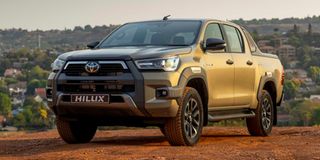The Hilux is a reliable workhorse

What you need to know:
For these motorists, the Hilux makes work easier since they can easily travel upcountry, through any road terrain, without fear of getting stuck, Roland D. Nasasira writes.
Albert Mugume
I am an engineer and because I usually travel upcountry for work, I needed a car with good ground clearance and the Toyota Hilux 2008, came in handy. I have now had it for two years and I do not regret my decision.
Its full tank capacity is 80 litres and before the increase in fuel prices, it would cost me approximately Shs300,000 to fuel. With a full tank, I can drive from Kampala to Kabale District in western Uganda and only refuel with Shs150,000 in Mbarara City on my way back to Kampala. My particular model runs on a 3000cc diesel which I find relatively friendly in terms of fuel consumption.
When fully loaded, I can comfortably drive at the 120km/hr mark without worry of skidding off the road and the car will still command high stability levels. The challenge is that this speed is not sustainable and safe in the long run because of reckless road users who may not be as careful. When driving over potholes or road bumps, I do not feel any discomfort since the Hilux is well raised and has a strong and reliable suspension system. If I was to choose another off-road car to drive on any rough roads, I would still choose the Hilux. It is a workhorse.
Mathew Tumwebaze
One of the features I like about the Toyota Hilux is its 4WD and the automatic transmission systems. The latest models, such as the 2010 one has an option of engaging and disengaging the system, depending on the road terrain.
For instance, as I returned from a friend’s burial in Kisoro District recently, it rained heavily making most of the marrum roads impassable. Many cars skidded and got stuck by the roadside but it took me just a press of a button to engage the 4WD system for the Hilux to move smoothly.
The secret to having the Hilux perform reliably on the road is making sure it is in roadworthy condition. One of the reasons most drivers pay high service costs is because they wait for mechanical issues to pile up. During service, I will replace the engine oil, spark plugs, fuel, air and oil filters, engine coolant and transmission fluid and this will cost me Shs400,000 once every three months. Replacing tyres costs close to Shs4m because one high performance tyre costs Shs800,000. Although they are expensive, I only replace them once in two years.
Mark Kalyango
I love the Toyota Hilux because it is an all-terrain car. I mostly drive it to my farms in Mubende District, and when carrying out field assessment surveys. I call it my garden tool of choice because it will go anywhere, regardless of the road condition.
During maize harvesting season, its cabin can carry up to 300 kilogrammes and transporting the maize will not have a significant impact on the car’s fuel consumption and suspension system. Its stability levels are also high when loaded because it becomes firm on the road.
Its maintenance is as affordable as its fuel consumption. I service my Hilux once in three to four months, depending on what needs to be replaced. Apart from the basic lubricants such as coolant and engine oil, I also pay attention to the most functional parts such as the suspension, wheel alignment and balance.
I replace the shock absorbers twice or once a year but this depends on where I have driven. A pair of shocks costs Shs1.5m while wheel alignment and balance cost Shs200,000. Minor service costs Shs300,000.
It is a car whose spare parts are locally available, although they are sometimes a bit costly. However, when you get the right original parts, there is value for money because they are durable.
Specifications
Body type Pick-up Truck
Fuel type Diesel
No. of cylinder 4
Transmission type Automatic




